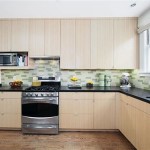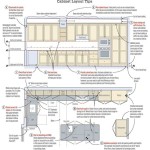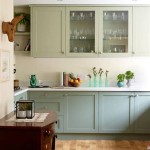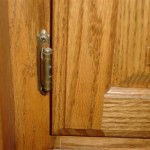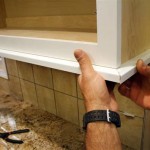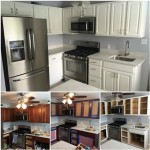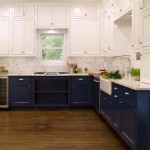Where To Put Knobs And Handles On Shaker Kitchen Cabinets
Shaker kitchen cabinets are characterized by their simple, clean lines and recessed panel doors. This minimalist design aesthetic contributes to their versatility, allowing them to integrate seamlessly into various kitchen styles, from traditional to contemporary. Selecting the appropriate hardware – knobs and handles – and determining their optimal placement is crucial for both the functionality and visual appeal of these cabinets.
The placement of knobs and handles is not merely an aesthetic decision. It impacts usability, ergonomics, and the overall efficiency of the kitchen workflow. Poorly placed hardware can lead to awkward movements, difficulty in accessing cabinet contents, and a visually unbalanced appearance. Therefore, a considered approach is necessary to ensure optimal placement that balances both form and function.
Several factors influence the ideal positioning of knobs and handles on Shaker cabinets. These include the size and style of the cabinet door or drawer, the overall kitchen design, and personal preferences. While there are general guidelines and best practices, the final decision should be tailored to the specific context of the kitchen and the user's needs.
Standard Placement Guidelines for Upper Cabinets
Upper cabinets, typically used for storing dishes, glassware, and other frequently accessed items, require hardware placement that facilitates easy opening and closing. A common approach is to position knobs or handles on the lower corner of the cabinet door, opposite the hinges. This placement offers a natural grip point and leverages the door's swing mechanism.
For upper cabinets, knobs are often preferred due to their smaller size and discreet appearance. Knobs are typically centered on the door frame stile or rail, depending on the door's construction. The exact vertical position can vary slightly based on the height of the door but is generally around 2-3 inches from the bottom corner. This ensures a comfortable reach and minimizes the risk of bumping into the hardware.
Handles are also suitable for upper cabinets, particularly in contemporary or transitional kitchens. When using handles on upper cabinets, they are usually mounted horizontally near the bottom corner of the door. The length of the handle should be proportional to the door's size. A handle that is too short can look out of place, while a handle that is too long may interfere with adjacent cabinets or appliances. A distance of 2-3 inches from the bottom corner is generally maintained for handles as well.
In the case of double upper cabinets (two doors meeting in the center), knobs or handles are usually positioned symmetrically on each door. This creates a balanced and visually appealing look. The placement should still adhere to the standard guidelines, with the hardware located on the opposite side of the hinges and near the bottom corner of each door. If using pulls they should be mounted so that the doors will be pulled away from each other.
When upper cabinets extend to the ceiling, the hardware placement remains consistent. The goal is to maintain a uniform aesthetic throughout the kitchen. Even though the upper cabinets might be less frequently used, the hardware should still be easily accessible and ergonomically sound.
Optimal Placement for Lower Cabinets and Drawers
Lower cabinets and drawers present unique considerations for hardware placement. Lower cabinets are typically used for storing heavier items, such as pots, pans, and large appliances. Drawers are commonly used for utensils, cookware, and food storage. The hardware selection and placement should reflect the functionality and accessibility of these units.
For lower cabinet doors, handles tend to be the preferred choice. The increased leverage provided by a handle makes it easier to open heavier doors, especially those storing bulky items. Handles are typically mounted vertically on the door stile, positioned near the top corner opposite the hinges. This placement allows for a comfortable grip and minimizes bending over to open the cabinet.
The length of the handle should be appropriate for the size of the cabinet door. Longer handles can enhance the visual impact and provide a more substantial grip. A common range for handle length on lower cabinets is between 5 and 7 inches. The exact placement can be adjusted slightly to accommodate the specific dimensions of the cabinet door.
Knobs can also be used on lower cabinet doors, particularly in smaller kitchens or where a more minimalist look is desired. When using knobs on lower cabinet doors, they are typically positioned similarly to upper cabinets, near the top corner opposite the hinges. However, it's important to consider the weight of the door and the effort required to open it. Handles generally offer better leverage for heavier doors.
Drawer hardware placement depends on the size and style of the drawer. For standard-sized drawers, knobs are often centered on the drawer front. The vertical position is typically somewhere between the top and middle of the drawer front, allowing for a comfortable reach. If the drawer has a recessed panel, the knob is usually centered within the panel.
For wider drawers, handles are generally preferred. Handles provide a more balanced and ergonomic grip, especially when the drawer contains heavy items. Handles are typically mounted horizontally on the drawer front. The placement can vary depending on the drawer's style and size, but a common approach is to center the handle horizontally and position it in the upper portion of the drawer front. The length of the handle should be proportional to the drawer's width.
For deeper drawers, two knobs or handles may be used to provide additional support and balance. In this case, the hardware is spaced evenly across the drawer front. The exact placement will depend on the drawer's dimensions and the desired aesthetic. Using two handles can provide a more robust and professional look, particularly in high-end kitchens.
Considerations for Specific Cabinet Types and Styles
Beyond standard upper and lower cabinets, certain cabinet types and styles require specific hardware considerations. Pantry cabinets, corner cabinets, and specialty cabinets often demand unique hardware solutions to optimize functionality and accessibility.
Pantry cabinets, which are typically tall and narrow, may require longer handles to facilitate easy opening and closing. The handles should be mounted vertically on the door, positioned at a comfortable height for the user. The length of the handle should be proportional to the door's height, ensuring a balanced and ergonomic grip. In some cases, two handles may be used on very tall pantry doors to provide additional support and stability.
Corner cabinets pose a particular challenge due to their unique shape and configuration. Blind corner cabinets, which have a portion of the cabinet hidden behind an adjacent cabinet, often require specialized hardware to improve accessibility. Pull-out shelves or swing-out organizers are commonly used in these cabinets, and their hardware should be positioned to facilitate smooth and easy operation. Knobs or handles should be placed in a location that allows for a comfortable grip and minimizes strain on the user.
For Lazy Susan corner cabinets, which feature rotating shelves, knobs or handles are typically mounted on the door or face frame of the cabinet. The placement should allow for easy access to the rotating shelves. It's important to ensure that the hardware does not interfere with the rotation of the shelves or obstruct access to the cabinet's interior.
Specialty cabinets, such as spice racks, wine racks, and appliance garages, may require custom hardware solutions. The hardware should be selected and positioned to complement the specific function and design of the cabinet. For example, spice racks may benefit from small, decorative knobs, while appliance garages may require sturdy handles that can support the weight of the door and the appliances being stored.
The overall style of the Shaker kitchen cabinets should also influence the hardware selection and placement. In traditional Shaker kitchens, simple, understated knobs and handles are often preferred. These hardware styles complement the clean lines and minimalist aesthetic of the cabinets. In contemporary Shaker kitchens, more modern and decorative hardware styles may be used to add a touch of personality and flair. The hardware finish should also be consistent with the overall kitchen design. Common finishes for Shaker kitchen cabinet hardware include brushed nickel, stainless steel, oil-rubbed bronze, and matte black.
Ultimately, the optimal placement of knobs and handles on Shaker kitchen cabinets is a balance of functionality, ergonomics, and aesthetics. Following these guidelines as a starting point will lead to a well-designed and user-friendly kitchen space. It is also a practical idea to test different positions before installation to ensure there will be no interferences when opening adjacent cabinets or appliances.

Cabinet Hardware Placement Guide For Shaker Cabinets

Cabinet Hardware Placement Guide For Shaker Cabinets

How To Place Cabinet Knobs Pulls

Learn How To Place Kitchen Cabinet Knobs And Pulls Cliqstudios

Cabinet Hardware Placement Guide For Shaker Cabinets

Learn How To Place Kitchen Cabinet Knobs And Pulls Cliqstudios

A Guide To Choosing Kitchen Cabinet Fittings

Cabinet Hardware Placement Guide For Shaker Cabinets

8 Top Hardware Styles For Shaker Kitchen Cabinets

8 Best Hardware Styles For Shaker Cabinets
Related Posts

